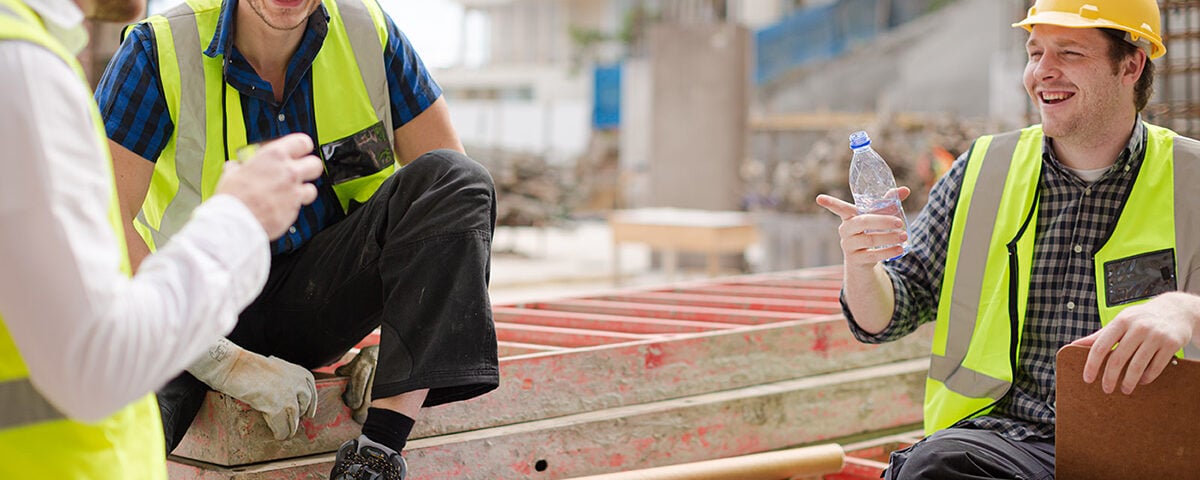
With happy employees and healthy, positive workplaces, safety is the default setting
My experience and learnings after a work accident
09 of March of 2022
Jason Anker’s astonishing story can help us make the connection between wellbeing and safety at work.
It was the first day back after the Christmas holidays in January 1993. It was cold, foggy and icy on the construction site where I was working as a roofing labourer – one of those days you really don’t want to be at work.
It had been a rough Christmas too. My marriage was in trouble and I had recently been made redundant.
At 2.30pm, a rushed job came in. In failing light, towards the end of shift, we had an hour to get a two-hour job done. About half an hour into it, I was 10ft up a ladder. Unfooted, unsupported, untied, I fell.
I couldn’t feel my legs straight away. I was taken to hospital. After an initial x-ray, the doctor walked in wearing a big smile. They thought it was spinal shock – a condition that might only last hours, days or a few weeks. I was one of the lucky ones.
Just to be on the safe side I had a CT scan. This time when he walked into the room, he wasn’t smiling. I knew. They had found a fracture in my back. There was a pause. He told me I would never walk again, then stood up and walked out of the room.
I was left lying there in a state of complete bewilderment. Total disbelief. I was 24 years old.
How an accident can affect your life
The period that followed was pretty traumatic. I started rehab, getting used to life in a wheelchair and just trying to be the best I could be. But on the day I was discharged from hospital, my wife left me. I’d lost my legs and my dignity and now I’d lost my marriage and my two young children.
I put on a brave face, laughing, joking and pretending I was okay, but I was really struggling. I relied on alcohol and drugs just as a way of coping. People were watching my life disintegrate but were powerless to help me.
An allergic reaction to taking ecstasy in 1995 left me in a coma for 17 days. My parents were advised to turn off the life support machine and told I would probably need 24-hour care for the rest of my life.
You would have expected that to be a turning point, but things got a lot worse. I was so ashamed of what I’d done.
My anxiety levels went through the roof. I was dreadfully unhappy, but trying to hide it from everybody. Alcohol was my crutch. I was bubbling along at the bottom of life, getting by one day at a time. It was simply about surviving.
In 2007, 14 years after my fall, I finally got compensation. People think your life will be totally better, but it made things worse again. With all that money in the bank, I tried to buy happiness.
Speak up about work safety
Then at a party came a chance meeting with behavioral safety expert Dan Terry. He asked me why I was in a wheelchair. He listened to my story and heard how my accident had affected everyone’s life.
I started working with Dan and tentatively began my public speaking career. Instead of showing a safety video, Dan would let me tell my real story.
I began to branch out on my own, giving presentations on construction and falls from heights. I set up a company Proud2bSafe to help people speak up about safety at work, their concerns about unsafe practices and near misses. I passionately felt this was the answer.
But I knew there was something else and I kept pushing myself to find more within my story.
A big change came three years ago. I started looking back a year before my accident, how my home life had been falling apart and all the added pressures that had been building up. I started thinking about my wellbeing, my mental health and my low morale and motivation for work.
I realised this had been the main contributing factor in my accident.
On that day in 1993, I can clearly remember standing at the bottom of the ladder. I stepped back, stopped and realised it was unsafe. I really thought about it and yet I still did it.
If I had been in a better headspace at that moment in time, I would have done things differently. If someone had just asked me ‘are you alright? are you okay today?’, I would have said ‘no’. Really and truthfully, I should never have been on a building site that day.
But it’s not always easy to speak up at work if you’re having a bad day or a bad time. You just tend to get on with it.
My new company, Anker and Marsh, focuses on people feeling better about themselves and their jobs. We take a holistic approach to health, safety and wellbeing. We actually think it should actually be wellbeing, health and safety. In that order.
We are joining the dots between best practice in safety and wellbeing, not looking at them as separate things.
Since the start of the COVID-19 pandemic, we have really moved forward. People are now making the connection between work and wellbeing. Companies are realising the need to make their workforce feel more valued.
Wellbeing affects how productive we are at work, the quality of the work we do, rates of absenteeism and discretionary effort. So there is a real financial benefit for companies in taking this seriously.
If people can have a good day at work and feel better about themselves, and you also have all your systems and procedures in place, then safety should be the default. That is the goal.
If you are having a bad time at home, then coming to a positive work environment is good for you. It should be a place where you feel you can step forward and say you’re having a bad time, a place where there is empathy for people sharing their issues.
We need education on how we should speak to people and how we should listen. Sometimes we just need to listen to see what’s going through people’s minds and in their lives.
All of us have challenges all of the time. It’s about normalising and destigmatising those conversations about mental wellbeing. I believe passionately that we can find a solution.
I can’t change what has happened to me. But hopefully by sharing my story I can change people’s perceptions of safety and its connection to mental health and wellbeing.





There are no comments yet